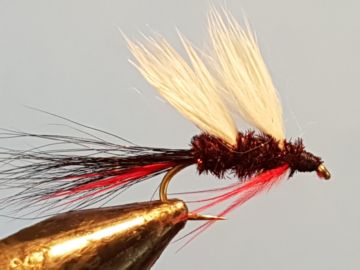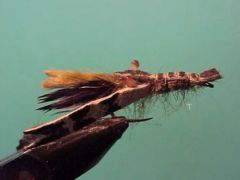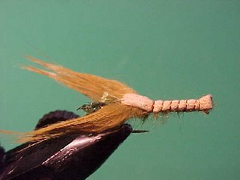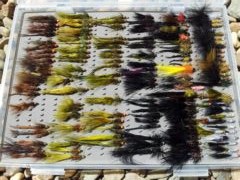Posts Tagged ‘Streamers’
{{start}}
It’s a subtle distinction between what I consider ‘loch style flies’ and what I consider ‘streamers and pulling flies’. The main difference for me is that by in large I regard each of my ‘loch’ flies as best when fished in a team of flies.
Alternatively as well as being useful point flies in a wet loch style team the flies that I set aside as ‘streamer and pulling flies also fish well by them selves. The list below are the few ‘streamer and pulling flies’ that like to carry in addition to my woolly bugger, booby, wee wet and nymph fly boxes to ensure that I have as many as possible of the lake fly fishing opportunities covered.
{{end}}

{{+1}}Claret caddis{{-1}}
{{start}}
Any time there are caddis on the wing this fly is worth a swim in the middle position of a team of three loch flies. One of the most important things to remember when tying this fly is not to overdress it ... make sure you can see a gap between the two wings even when the rabbit fur is dry and fluffed out.{{end}}

{{+1}}Zonker yabby / crayfish{{-1}}
{{start}}
Over the years I have experimented with various Yabby Patterns and whilst some have looked great unfortunately they have all been “dogs” to fish or more correctly to cast. Generally rather than using them I have reverted to fishing a weighted woolly bugger instead. Well all that has now changed and I now have a Yabby in my fly box that I have confidence in.{{end}}

{{+1}}Cormorant{{-1}}
{{start}}
Cormorant flies have plenty of movement generated through the wispy marabou wing that extends the full length of the fly and has, as a hot spot, a very visible chartreuse tag.{{end}}

{{+1}}Silver & olive yeti – Chatto’s variant{{-1}}
{{start}}
My standard Yeti variant is a very successful fly but every now and again you need something a bit mor flashy. This fly fills that gap in my fly box. In smaller sizes I prefer my Bag Fly or my Tom Jones.{{end}}

{{+1}}Sinking yabby / crayfish{{-1}}
{{start}}
Over the years I have experimented with various Yabby patterns and whilst some have looked great unfortunately they have all been “dogs” to fish or more correctly to cast. Generally rather than using them I have reverted to fishing a weighted woolly bugger instead. Well all that has now changed and I now have a Yabby in my fly box, in both a floating and sinking version, that I have confidence in.{{end}}

{{+1}}Woolly worm{{-1}}
{{start}}
This is an old pattern and whilst it can be dressed in many different ways I prefer it dressed as described below which is similar to the original form with the exception of the tail which I prefer to be much finer than the original. I guess that makes it like a small Woolly Bugger. This fly works well in streams when fished across and down and is also a useful fly when fish are in still water mooching amongst flotsam & jetsam.{{end}}

{{+1}}Smelt – Chatto’s version{{-1}}
{{start}}
It tied this fly when last in New Zealand as a merger of a couple of flies to represent their small native fish called a Cockabully. I used it quite successfully fishing the seams in in fast rivers on a fast sink line and decided it add it to my fly box for future use. I am confident that with less weight it will also be a great lake fly and I expect that it can also be used as an imitation to other small bait fish either in the colour below or other hues.{{end}}

{{+1}}Kalkite special{{-1}}
{{start}}
This fly has stood the test of time and has been on this web site since 2005. Over the last 10 or so years it has been my 'go to' fly when fishing to sighted fish or prospecting the shores of Lake Jindabyne particularly around our home village of Kalkite.{{end}}

{{+1}}Floating yabby / crayfish{{-1}}
{{start}}
A floating yabby is a bit of an oxymoron but it does work. Fish it on a fast sink line and let the line sink to the required depth. When you pull the line the floating yabby will be pulled down. When you pause the yabby will rise. Bass love it.{{end}}

{{+1}}My “trout” fly boxes{{-1}}
{{start}}
The number of fly boxes you carry is obviously one of personal choice. One difficulty you may encounter when you are setting up your fly boxes is which flies you should include, and how many flies you should carry in your fly box or boxes. The last thing you want to be doing is standing on the bank of a river madly pulling flies out to find a fly you know is there . . .somewhere, but it isn't where you expected to find it or you fly box or boxes are so crowded with flies that the one you are desperately looking for is hidden away . . . somewhere.{{end}}













